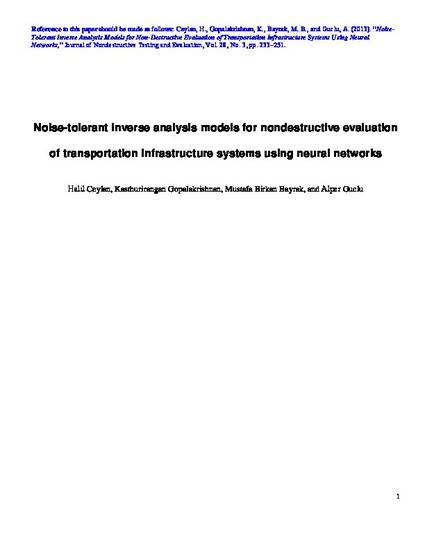
The need to rapidly and cost-effectively evaluate the present condition of pavement infrastructure is a critical issue concerning the deterioration of ageing transportation infrastructure all around the world. Nondestructive testing (NDT) and evaluation methods are well-suited for characterising materials and determining structural integrity of pavement systems. The falling weight deflectometer (FWD) is a NDT equipment used to assess the structural condition of highway and airfield pavement systems and to determine the moduli of pavement layers. This involves static or dynamic inverse analysis (referred to as backcalculation) of FWD deflection profiles in the pavement surface under a simulated truck load. The main objective of this study was to employ biologically inspired computational systems to develop robust pavement layer moduli backcalculation algorithms that can tolerate noise or inaccuracies in the FWD deflection data collected in the field. Artificial neural systems, also known as artificial neural networks (ANNs), are valuable computational intelligence tools that are increasingly being used to solve resource-intensive complex engineering problems. Unlike the linear elastic layered theory commonly used in pavement layer backcalculation, non-linear unbound aggregate base and subgrade soil response models were used in an axisymmetric finite element structural analysis programme to generate synthetic database for training and testing the ANN models. In order to develop more robust networks that can tolerate the noisy or inaccurate pavement deflection patterns in the NDT data, several network architectures were trained with varying levels of noise in them. The trained ANN models were capable of rapidly predicting the pavement layer moduli and critical pavement responses (tensile strains at the bottom of the asphalt concrete layer, compressive strains on top of the subgrade layer and the deviator stresses on top of the subgrade layer), and also pavement surface deflections with very low average errors comparable with those obtained directly from the finite element analyses.
Available at: http://works.bepress.com/halil_ceylan/279/

This is an accepted manuscript of an article published by Taylor & Francis in Nondestructive Testing and Evaluation on January 18, 2013, available online: http:// www.tandf.com/10.1080/10589759.2012.742084.